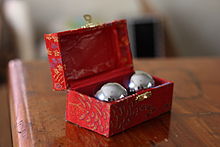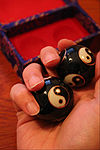- Baoding balls
-
Baoding balls (Chinese: 保定健身球; pinyin: Bǎodìng Jiànshēn Qiú, literally "Baoding physical exercise balls") are also known as Chinese exercise balls, Chinese meditation balls, Chinese medicine balls, and healthy balls. They are a traditional product of Baoding, China, thought to have been created during the Ming dynasty. Two or more Baoding balls are rotated repetitively in the hand to improve manual dexterity and strength, and they are also said to assist in injury recovery.
Contents
History
Baoding balls are believed to have originated in Baoding, a town in the Hebei province of China, during the Ming Dynasty. They were once called "Chinese iron balls", since they were originally made of iron. As of 2011, there are still artisans in Baoding who produce the meditation balls.[1]
Materials and composition
As Baoding balls became more popular and metalworking skills improved, construction methods varied. Most Baoding balls made and used today are constructed as a pair of hollow spheres, one inside the other, with a chime between which rings as the inner ball strikes it. Many modern examples are decorated with cloisonné and brass wire; however, these are not as suitable for actual use because they can easily chip when dropped or when they come into contact with each other. For injury recovery, hollow balls are generally more suitable due to their lighter weight. For exercise purposes balls made of solid iron, steel or tungsten carbide provide added weight, requiring more effort to rotate.
Use
The basic exercise consists of rotating a pair of Baoding balls in the palm of the hand, ensuring even and constant contact is made between the balls. Once this has been learned, the rotation speed can be gradually increased until the balls separate in the hand. Eventually one can learn to rotate them completely without the balls making contact with each other. Exercises have been developed involving two, three, four or more balls.
The average person should be able to start with a 45-millimeter (1.8 in) diameter ball, moving up to the 60-millimeter (2.4 in) size as their muscles get accustomed to the exercise. Larger Baoding balls (70–100 millimeters (2.8–3.9 in)) can be used, although eventually it is impossible to rotate them without touching. The area of the hand exercised can be varied at advanced levels of practice, altering the portion of the hand they rotate over, or changing the orbit of the balls in the hand so that more force is exerted on a particular finger or particular finger joints. Well-known bodybuilders such as John Brookfield use large shot-put balls as Baoding balls, rotating them to develop forearm muscles and improve grip.
In Popular Culture
Baoding balls are used by the character CLU 2 in Tron: Legacy; this occurs in the arena scene as Sam Flynn battles Rinzler/TRON. Kevin Flynn himself is seen to have a similar pair of objects as decor in his home, but which are actually Yoshimoto Cubes that are spiked instead of rounded and resemble the Bit of the original Tron.
Aerosmith included clips of Baoding balls (including skull-shaped ones) being rotated in their music video for the song "Eat the Rich."[2]
Cptn Philip Francis Queeg (Humphrey Bogart) The Caine Mutiny (1954)
Gallery
Notes
External links
Categories:- Traditional Chinese objects
- Exercise equipment
- Balls
Wikimedia Foundation. 2010.




